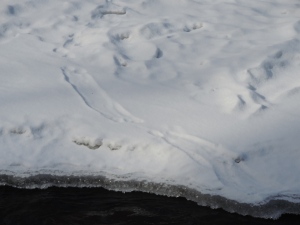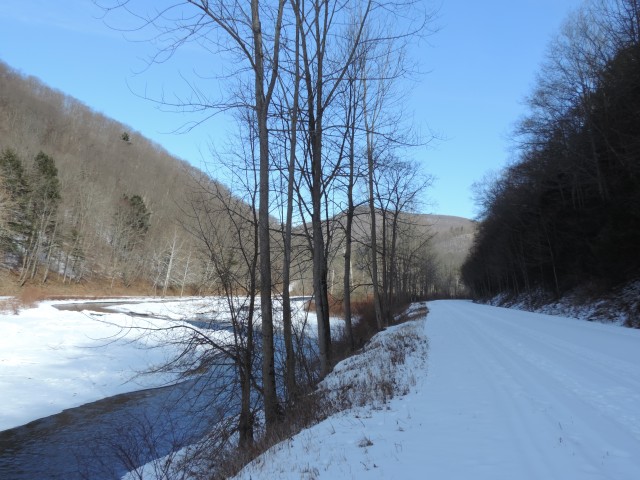“It is the life of the crystal, the architect of the flake, the fire of the frost, the soul of the sunbeam. This crisp winter air is full of it.” –John Burroughs
The winter air in the Pine Creek Natural Area, aka the Pine Creek Gorge, or the Grand Canyon of Pennsylvania, was all of this and more.
 I took a four-mile ramble on the canyon’s Rail Trail following the mostly ice-covered waters of upper Pine Creek. The air was a crisp 23 degrees Fahrenheit, although the sun was shining now and then, illuminating the snow and ice and the several tracks of skiers and hikers.
I took a four-mile ramble on the canyon’s Rail Trail following the mostly ice-covered waters of upper Pine Creek. The air was a crisp 23 degrees Fahrenheit, although the sun was shining now and then, illuminating the snow and ice and the several tracks of skiers and hikers.
I had total solitude in this 20-mile stretch of wildness flowing north to south at depths of a thousand feet below the sandstone escarpments at each rim. Oh, I saw a great blue heron and a pileated woodpecker and an animal which I’ll speak of in a minute, but I felt quite sheltered from the mundane world. The “longest creek in America” was at my feet, and a vast state forestland embraced the cliffs just east and west of me.
 The Pine Creek Gorge Natural Area contains (according to a 1960s report by the National Park Service) “superlative scenery, geological and ecological value, and is one of the finest examples of a deep gorge in the eastern United States.”
The Pine Creek Gorge Natural Area contains (according to a 1960s report by the National Park Service) “superlative scenery, geological and ecological value, and is one of the finest examples of a deep gorge in the eastern United States.”
I agree, and feel the need to finally do some fly-fishing here along the creek’s Delayed Harvest water in April. I have visited the gorge on many occasions over the last few decades but have never rafted its course from Ansonia to Blackwell or even traversed it with a fly rod or a bicycle along the popular Rail Trail.
I don’t know what I’ve been waiting for, but since I’m not getting any younger, there is no time like the present to become better acquainted. Lots of people take a raft, canoe or kayak through the gorge when the flow is good, but my own thoughts settle with a trail bike– ah, to pedal, and to stop at each side canyon for a bit of brook trout fishing with a short four-piece rod…
no time like the present to become better acquainted. Lots of people take a raft, canoe or kayak through the gorge when the flow is good, but my own thoughts settle with a trail bike– ah, to pedal, and to stop at each side canyon for a bit of brook trout fishing with a short four-piece rod…
This natural area was a gift from the last Ice Age when the melting glaciers thwarted Pine Creek’s northward flow and reversed it through impressionable sandstone. The creek, rerouted, helped to carve this complicated landscape of forested hills and gorges. This was wilderness until the late nineteenth-century logging boom occurred.
 I was near Deadman Hollow, named for an early twentieth-century trapper whose decomposed body was found in a bear trap he had set. Earlier, the Iroquois and Susquehannock hunters had traveled this course for many years. More recently, the Jersey Shore, Pine Creek and Buffalo Railway had traversed the gorge with passenger and freight service, forming the backbone for the 13 logging companies that eventually established themselves in the larger watershed.
I was near Deadman Hollow, named for an early twentieth-century trapper whose decomposed body was found in a bear trap he had set. Earlier, the Iroquois and Susquehannock hunters had traveled this course for many years. More recently, the Jersey Shore, Pine Creek and Buffalo Railway had traversed the gorge with passenger and freight service, forming the backbone for the 13 logging companies that eventually established themselves in the larger watershed.
The old growth forests were stripped bare by the early 1900s. Nothing was left but treetops which eventually fueled great fires that ravaged the land. Along with the floods that followed the fires, there were landslides and erosion to the point of ecological ruin. The region took on the appearance of a desert.
Over the past century, however, the forests have regrown and much of the wildlife has returned. Although the wolves and elk and panthers are gone, the bears and otters and eagles can be found, and wild trout thrive in many of Pine Creek’s tributaries.
Visitors arrive en masse to enjoy the state parks, hiking trails and waterways. Following the demise of the train era, the Rail Trail opened in 1996 and has become very popular with bicyclists, hikers, anglers, and other recreationalists.
This hiker had neglected to carry food and water, thinking at first he wouldn’t walk so far, and he became thirsty after the first mile of rambling. I was at the point of scooping up snow when I heard the song of water from the rocks on my left. Water was gushing from a pipe thrust outward from the cliff. Wonderful!
Returned to the trail, I glanced at an open stretch of water in the creek. A dark-furred animal stood 50 feet away on the edge of the ice, its eyes already well-fastened to my being. River otter! There it was, my first good look at an otter in the East. I’ve seen this animal in some western states, but this was special.
I wanted a photo of the moment, but the unblinking eyes told me it wouldn’t be easy. I positioned my walking stick, slowly removed my gloves, and tried to ready the camera. Looking up from my settings I saw that the river otter was gone– the photo wasn’t meant to be, not now, although I managed to capture the animal’s unusual tracks.
Otters were reintroduced to the Pine Creek Natural Area from other regions of the wild about 20 to 25 years ago, and they’ve been doing well. These fast swimming fish-eaters require pristine water conditions, and there’s plenty of suckers and stocked trout in the Pine to keep them healthy.
Maybe on my next excursion I’ll get lucky with the camera.


Glad you got it posted! It looks like it was a really fruitful ramble, but you otter be more prepared with the camera next time.
Yes, and I otter be glad I got some technical assistance here, as well. Thanks!
Awesome! I’ve never seen an otter in the wild, though there are supposed to be some on the Tionesta and on the Clarion River. I did, however, find what I believe to be a bobcat den. I was snowshoeing at Chapman SP, looking for a rock overlook on a ridge that I hadn’t been to in years. Found it, and found a trail that looked like an otter slide going down the hill. About 8 inches deep and wide, there were fresh tracks in it but a light snow that morning had obscured any detail. The trail led to a small opening among the rocks and it looked plenty worn around the entrance – I didn’t get too close, ’cause I’m sure the critter was in there. If I had a trail camera, I’d put it out and catch him en route. I went up to Allegany State Park last week, too. Haven’t been there in several years, but I’m gonna have to spend some time there in the future. Do you ever get over that way?
Hey Bob,
An otter sighting always seems special to me, and I was kind of lucky getting this one because I was on Pine when the open water was limited, thus constricting the travel range of the animal and making them more obvious. That must’ve been fun getting close to a bobcat on the ridge. For years I went looking for one in my area, then last winter surprised one hiding under a spruce bough within a stone’s throw of my house! Just last weekend I found fresh tracks on the stream and will post a photo of them sometime. As for ASP in New York, I haven’t been there in quite some time, but would like to get back to the trails and streams there in the future. Maybe we can do a little brook trout fishing there on some fine day?
Absolute beautiful scenery, and seeing the otter made in even more special. Beautiful stream and easy to fish ; have you written a post concerning this stream? Thanks for sharing
Thank you, Bill. Pine is an easy stream to fly-fish, lots of accessibility but also with lots of potential for getting out into remote areas. It’s a beauty though it does get rather marginal in places for trout come summertime. I haven’t yet written a lot about this stream directly, having focused mostly on its upper tributaries, but plan to do more in the future.
Interesting history behind the creek’s origin and the area generally. I see about one or two otters a year down here, always during the winter and usually within the same one-square-mile area.
Glad you’re seeing some otters, Jim. When river otter populations took a terrible hit in the last century, they fared better in your section of the woods, along with other coastal areas such as the Louisiana marshes, than around the northeastern regions, or so I’ve been led to believe. In any case, they require clean, unpolluted water to survive, so to see them where you live is a very good sign. Thanks for taking an interest in the Pine Creek environment.